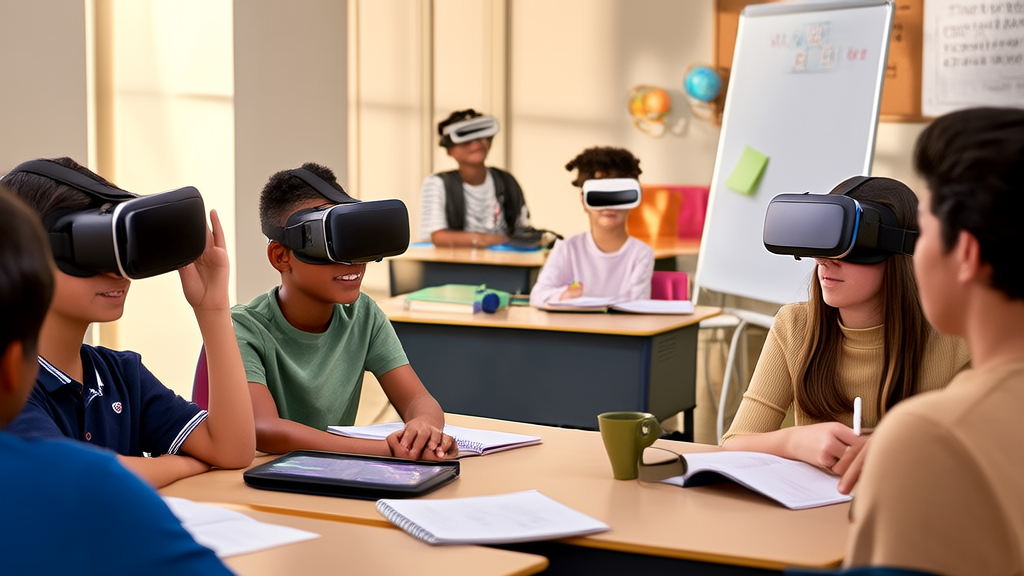5 Cutting-Edge K12 Teaching Methods Boosting Student Success in 2025

Empowering the Future: Navigating K12 Education in 2025
Welcome to the future of education! As we stand in the year 2025, the landscape of K12 education is more dynamic and innovative than ever. From cutting-edge teaching methodologies to the integration of advanced technology, today's educational environment is designed to nurture well-rounded, curious, and capable students. Whether you're a parent or an educator, this blog post will provide you with valuable insights, practical tips, and inspiring success stories to help you navigate and support your child's or student's learning journey.
Latest Teaching Methodologies and Their Effectiveness
In recent years, several new teaching methodologies have emerged, each with its unique approach to fostering student engagement and learning. One such method is Project-Based Learning (PBL). PBL encourages students to explore real-world problems and challenges, promoting critical thinking, collaboration, and problem-solving skills. For example, at High Tech High in San Diego, students engage in projects that require them to apply their knowledge across multiple subjects, resulting in higher levels of retention and a deeper understanding of the material.
Another effective methodology is Blended Learning, which combines traditional face-to-face classroom instruction with online learning. This approach allows for personalized learning experiences, as students can work at their own pace and access additional resources. A study by the Clayton Christensen Institute found that blended learning can lead to significant improvements in student achievement, particularly in math and reading.
Child Development Insights and Research
Understanding child development is crucial for both parents and educators. Recent research has highlighted the importance of social-emotional learning (SEL) in the overall development of children. SEL focuses on helping students develop self-awareness, self-management, social awareness, relationship skills, and responsible decision-making. According to a report by the Collaborative for Academic, Social, and Emotional Learning (CASEL), schools that implement SEL programs see improvements in academic performance, behavior, and mental health.
Additionally, the concept of growth mindset has gained traction in educational circles. Developed by psychologist Carol Dweck, a growth mindset emphasizes the belief that abilities and intelligence can be developed through dedication and hard work. Encouraging a growth mindset in students can lead to increased resilience, motivation, and a love for learning. Teachers and parents can foster a growth mindset by praising effort rather than innate ability and by providing opportunities for students to learn from their mistakes.
Educational Technology Trends
Technology continues to play a pivotal role in K12 education, offering new and exciting ways to enhance learning. One of the most significant trends is the use of Artificial Intelligence (AI) in the classroom. AI-powered tools can provide personalized learning experiences, adapt to individual student needs, and offer real-time feedback. For instance, platforms like DreamBox Learning use AI to create customized math lessons that adjust to each student's progress and understanding.
Another trend is the integration of Virtual Reality (VR) and Augmented Reality (AR) into the curriculum. These technologies can bring abstract concepts to life, making learning more engaging and immersive. For example, Google Expeditions allows students to take virtual field trips to historical sites, museums, and even outer space, providing a rich and interactive learning experience.
Practical Tips for Parents and Teachers
For parents, staying involved in your child's education is key. Here are some practical tips:
- Communicate regularly with teachers: Stay informed about your child's progress and any areas where they may need extra support.
- Create a supportive home learning environment: Set up a dedicated space for homework and ensure it is free from distractions.
- Encourage a growth mindset: Praise your child's effort and perseverance, and help them see challenges as opportunities for growth.
- Stay informed about educational technology: Familiarize yourself with the tools and platforms your child is using, and explore how you can support their learning at home.
For teachers, here are some actionable strategies:
- Implement project-based learning: Design projects that allow students to apply their knowledge in real-world contexts and collaborate with peers.
- Integrate social-emotional learning: Incorporate activities and discussions that promote self-awareness, empathy, and responsible decision-making.
- Utilize educational technology: Explore AI-powered tools and VR/AR applications to enhance your teaching and make learning more engaging.
- Provide regular feedback: Offer constructive and timely feedback to help students understand their strengths and areas for improvement.
Success Stories and Case Studies
One inspiring success story comes from the Summit Public Schools in California, which implemented a personalized learning platform called the Summit Learning Program. This program uses a combination of project-based learning, one-on-one mentoring, and self-paced learning to meet the individual needs of each student. The results have been impressive, with higher graduation rates, improved college readiness, and increased student engagement.
Another case study is the use of AI in the classroom at AltSchool, a network of micro-schools in the United States. AltSchool uses AI to create personalized learning plans for each student, allowing teachers to focus on individualized instruction and support. The school has seen significant improvements in student outcomes, with many students outperforming their peers in traditional schools.
Conclusion
The future of K12 education is bright and full of possibilities. By embracing the latest teaching methodologies, understanding child development, leveraging educational technology, and implementing practical tips, parents and educators can create a supportive and enriching learning environment for our children. Let's work together to empower the next generation and prepare them for a world of endless opportunities.
Join us in shaping the future of education. Share your thoughts, experiences, and questions in the comments below. Together, we can make a difference!